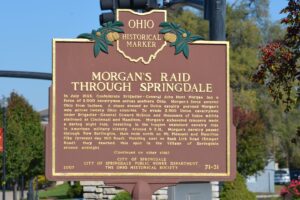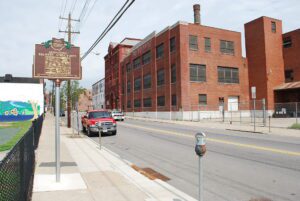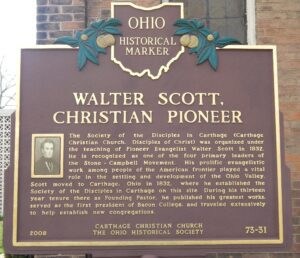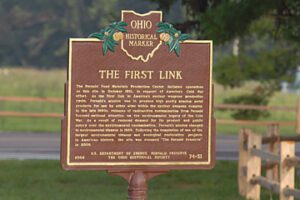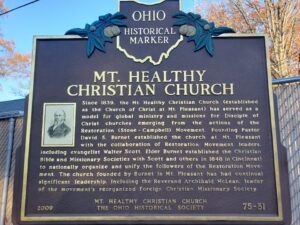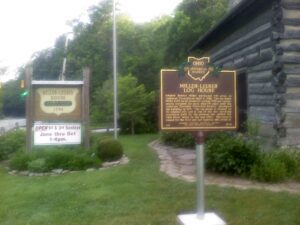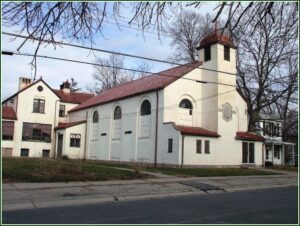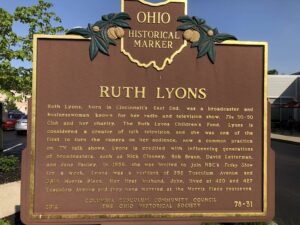, OH
In July 1863, Confederate Brigadier-General John Hunt Morgan led a force of 2,000 cavalrymen across southern Ohio. Morgan’s force entered Ohio from Indiana. A chase ensued as Union cavalry pursued Morgan’s men across twenty Ohio counties. To evade 2,500 Union cavalrymen under Brigadier-General Edward Hobson and thousands of Union militia stationed at Cincinnati and Hamilton, Morgan’s exhausted troopers made a daring night ride, resulting in the longest sustained cavalry ride in American military history. Around 9 P.M., Morgan’s cavalry passed through New Burlington, then rode north on Mt. Pleasant and Hamilton Pike (present day Mill Road). Heading east on Bank Lick Road (Kemper Road), they reached this spot in the Village of Springdale around midnight. (Continued on other side)
, OH
The Brewery District contains the majority of Cincinnati’s remaining breweries and associated structures such as icehouses, bottling buildings, offices, and stables. With the first brewery north of Liberty Street founded in1829, German immigrants fueled the growth of the brewing industry; by 1891, Cincinnati breweries produced over four barrels of beer per resident annually, almost twice as much as any other city in the nation. The brick breweries were typically designed in the Romanesque Revival style, and larger complexes often covered multiple city blocks. To produce the lager style beer common by 1860, typically very deep basements were dug or tunnels were cut into hillsides for the lagering process. At the height of production, 18 of the 36 breweries in greater Cincinnati were operating in Over-the-Rhine and the West End. Prohibition in 1919 closed most of the breweries permanently.
, OH
The Society of the Disciples in Carthage (Carthage Christian Church, Disciples of Christ) was organized under the teaching of Pioneer Evangelist Walter Scott in 1832. He is recognized as one of the four primary leaders of the Stone-Campbell Movement. His prolific evangelistic work among people of the American frontier played a vital role in the settling and development of the Ohio Valley. Scott moved to Carthage, Ohio in 1832, where he established the Society of the Disciples in Carthage on this site. During his thirteen year tenure there as Founding Pastor, he published his greatest works, served as the first president of Bacon College, and traveled extensively to help establish new congregations.
, OH
The Fernald Feed Materials Production Center initiated operations on this site in October 1951, in support of America’s Cold War effort. As the first link in America’s nuclear weapons production cycle, Fernald’s mission was to produce high purity uranium metal products for use by other sites within the nuclear weapons complex. In the late 1980s, releases of radioactive contamination from Fernald focused national attention on the environmental legacy of the Cold War. As a result of reduced demand for its product and public outcry over the environmental contamination, Fernald’s mission changed to environmental cleanup in 1989. Following the completion of one of the largest environmental cleanup and ecological restoration projects in American history, the site was renamed “The Fernald Preserve” in 2006.
, OH
Since 1839, the Mt. Healthy Christian Church (established as the Church of Christ at Mt. Pleasant) has served as a model for global ministry and missions for Disciple of Christ churches emerging from the actions of the Restoration (Stone-Campbell) Movement. Founding Pastor David S. Burnet established the church at Mt. Pleasant with the collaboration of Restoration Movement leaders, including evangelist Walter Scott. Elder Burnet established the Christian Bible and Missionary Societies with Scott and others in 1848 in Cincinnati to nationally organize and unify the followers of the Restoration Movement. The church founded by Burnet in Mt. Pleasant has had continual significant leadership, including the Reverend Archibald McLean, leader of the movement’s reorganized Foreign Christian Missionary Society.
, OH
Ichabod Benton Miller purchased 440 acres in Anderson Township on April 2, 1796. The log house Miller built on his property around 1796 was continuously occupied for more than 170 years until the Anderson Township Historical Society purchased the building in 1971. The log house is located on its original site and is one of the few surviving structures built by the pioneers who settled the Ohio River Valley in the late 1700s. The house is named for the first and last families who owned it.
, OH
Eckstein Elementary School operated on this site from 1915 to 1958, serving Glendale’s Negro children from Kindergarten through eighth grade. The school was named in honor of Eleanor Eckstein, who taught the children at various locations in the village during the time of segregation in America. Upon completing eighth grade, Eckstein School’s students were integrated with their white counterparts in grades nine through twelve at Congress Avenue School. The Eckstein School building evolved from a single family dwelling into its present structure through a series of expansions, the last of which was the addition of the gymnasium in 1928. In the mid-1950s Glendale became a part of the Princeton School District. A new consolidated high school opened in 1958, the Congress Avenue School became Glendale Elementary, and Eckstein was closed. This commemorative text was composed by alumni of the Eckstein School.
, OH
Ruth Lyons, born in Cincinnati’s East End, was a broadcaster and businesswoman known for her radio and television show, The 50-50 Club and her charity, The Ruth Lyons Children’s Fund. Lyons was considered a creator of talk television and she was one of the first to turn the camera on her audience, now a common practice on TV talk shows. Lyons is credited with influencing generations of broadcasters, such as Nick Clooney, Bob Braun, David Letterman, and Jane Pauley. In 1858, she was invited to join NBC’s Today Show for a week. Lyons was a resident of 332 Tusculum Avenue and 3614 Morris Place. Her first husband, John lived at 420 and 427 Tusculum Avenue and they were married at the Morris Place residence.


